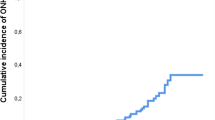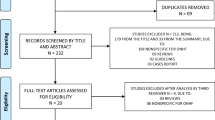Abstract
The mechanisms involved in the pathogenesis of osteonecrosis of the femoral head in sickle cell disease are not fully known. The aim of this study was to identify risk factors for osteonecrosis of the femoral head among sickle cell disease patients. Clinical (frequency of painful crises and hospitalisation) and laboratory parameters (euglobulin clot lysis time, haematocrit, platelet count, and leucocyte count) of 25 consecutive patients with avascular necrosis of the femoral head from sickle cell disease were compared with those of 26 age- and sex-matched sickle cell disease patients without avascular necrosis. The group with avascular necrosis of the femoral head (mean age 23.7±4.9 years) had a significantly higher rate of painful crises (p = 0.03) and hospitalisations per year (p = 0.002) than the group without avascular necrosis (mean age 21.6±5.2 years). The group with avascular necrosis also had a significantly higher euglobulin clot lysis time than the group without avascular necrosis (p = 0.001). In conclusion, it appears that not all patients with sickle cell disease have impaired fibrinolytic activity. The aetiology of avascular necrosis in sickle cell disease is multifactorial.
Résumé
Les mécanismes de la nécrose de la tête fémorale dans la drépanocytose sont encore relativement obscures. Le but de cette étude est de mettre en évidence les facteurs de risque de la tête fémorale chez les patients présentant une drépanocytose. Matériel et méthode : l’évaluation des paramètres cliniques (fréquence des crises, nombre d’hospitalisations) et biologique (lyse du caillot, euglobuline, hématrocrite, plaquettes et numération leucocytaire) de 25 patients consécutifs présentant une nécrose avasculaire de la tête fémorale dans le cadre d’une drépanocytose ont été comparés aux données d’une série de patients âgés en moyenne de 26 ans et présentant une drépanocytose sans nécrose aseptique. Résultats : le groupe des nécroses aseptiques de tête fémorale était âgé en moyenne de 23,7 ± 4,9 avec un nombre de crises douloureuses significativement plus élevé (p = 0,03) et un nombre d’hospitalisation également plus élevé (p = 0,002) que dans le groupe des nécroses avasculaires simples, moyenne d’âge 21,6 ± 5,2 ans. Le groupe présentant une nécrose avasculaire présentant également un taux de lyse du caillot et d’euglobuline plus élevé que dans le groupe sans nécrose (p = 0,001). Conclusion : il semble que les patients porteurs d’une drépanocytose comportent sur le plan biologique une activité fribrinolytique plus importante. L’étiologie de la nécrose avasculaire dans le cadre de la drépanocytose est multifactorielle.
Similar content being viewed by others
References
Adekile AD, Gupta R, Yacoub F, Sinan T, Al-Bloushi M, Haider MZ (2001) Avascular necrosis of the hip in children with sickle cell disease and the high Hb F: magnetic resonance imaging findings and influence of alpha-thalassemia trait. Acta Haematol 105(1):27–31
Akinyoola AL, Adediran IA, Asaleye CM (2007) Avascular necrosis of the femoral head in sickle cell disease in Nigeria: a retrospective study. Niger Postgrad Med J 14(3):217–220
Aluoch JR (1998) Fibrinolytic activity in adult Kenyan patients with sickle cell disease. East Afr Med J 75(6):351–352
Bain BJ (1995) Basic haematological techniques. In: Dacie JV, Lewis SM (eds) Practical haematology, 8th edn. Churchill Livingstone, London, pp 37–66
Bayazit AK, Kilinc Y (2001) Natural coagulation inhibitors (protein C, Protein S, antithrombin) in patients with sickle cell anemia in a steady state. Pediatr Int 43(6):592–596
Busari FI, Shokunbi WA, Jeremiah ZA (2007) Plasma fibrinogen levels in Nigerian homozygous (Hb SS) sickle cell patients. Hemoglobin 31(1):89–92
Dacie JV, Lewis SM (1995) Preparation and staining methods for blood and bone marrow film. In: Dacie JV, Lewis SM (eds) Practical haematology, 8th edn. Churchill Livingstone, London, pp 75–85
Famodu AA (1988) Plasma fibrinolytic activity in sickle cell disease. Trop Geogr Med 40(4):331–333
Hawker H, Neilson H, Hayes RJ, Serjeant GR (1982) Haematological factors associated with avascular necrosis of the femoral head in homozygous sickle cell disease. Br J Haematol 50(1):29–34
Hernigou P, Habibi A, Bachir D, Galacteros F (2006) The natural history of asymptomatic osteonecrosis of the femoral head in adults with sickle cell disease. Bone Joint Surg Am 88(12):2565–2572
Iwegbu CG, Fleming AF (1985) Avascular necrosis of the femoral head in sickle cell disease. A series from the Guinea savannah of Nigeria. J Bone Joint Surg (Br) 67(1):29–3
Jones LC, Mont MA, Le TB, Petri M, Hungerford DS, Wang P, Glueck CJ (2003) Procoagulants and osteonecrosis. J Rheumatol 30(4):783–791
Koo KH, Song HR, Ha YC, Kim JR, Kim SJ, Kim KI, Chang KC, Ahn IO, Cho SH (2002) Role of thrombotic and fibrinolytic disorders in the etiology of Perthes’ disease. Clin Orthop Relat Res 399:162–167
Kurantsin-Mills J, Ofosu FA, Safa TK, Siegel RS, Lessin LS (1992) Plasma factor VII and thrombin-antithrombin III levels indicate increased tissue factor activity in sickle cell patients. Br J Haematol 81(4):539–544
Lee JS, Koo KH, Ha YC, Koh KK, Kim SJ, Kim JR, Song HR, Cho SH (2003) Role of thrombotic and fibrinolytic disorders in osteonecrosis of the femoral head. Clin Orthop Relat Res 417:270–276
Milner PF, Kraus AP, Sebes JI, Sleeper LA, Dukes KA, Embury SH et al (1991) Sickle cell disease as a cause of osteonecrosis of the femoral head. N Engl J Med 325(21):1476–1481
Mukisi-Mukaza M, Elbaz A, Samuel-Leborgne Y, Keclad L, Le Turdu-Chicot C, Christophe-Duchange E, Merault G (2000) Prevalence, clinical features, and risk factors of osteonecrosis of the femoral head among adults with sickle cell disease. Orthopedics 23(4):357–363
Nsiri B, Gritli N, Bayoudh F, Messaoud T, Fattoum S, Machghoul S (1996) Abnormalities of coagulation and fibrinolysis in homozygous sickle cell disease. Hematol Cell Ther 38(3):279–284
Posan E, Szepesi K, Gaspar L, Csernatony Z, Harsfalvi J, Ajzner E, Toth A, Udvardy M (2003) Thrombotic and fibrinolytic alterations in the aseptic necrosis of femoral head. Blood Coagul Fibrinolysis 14(3):243–248
Urano T, Sakakibara K, Rydzewski A, Urano S, Takada Y, Takada A (1990) Relationship between euglobulin clot lysis time and the plasma levels of tissue plasminogen activator and plasminogen activator inhibitor 1. Thromb Haemost 63(1):82–86
Von Kaulla KN (1963) Chemistry of thrombosis. Human fibrinolytic system. Charles C Thomas, Illinois, pp 49–60
Author information
Authors and Affiliations
Corresponding author
Rights and permissions
About this article
Cite this article
Akinyoola, A.L., Adediran, I.A., Asaleye, C.M. et al. Risk factors for osteonecrosis of the femoral head in patients with sickle cell disease. International Orthopaedics (SICOT) 33, 923–926 (2009). https://doi.org/10.1007/s00264-008-0584-1
Received:
Revised:
Accepted:
Published:
Issue Date:
DOI: https://doi.org/10.1007/s00264-008-0584-1




